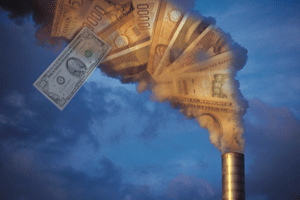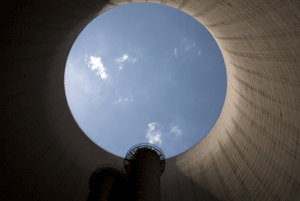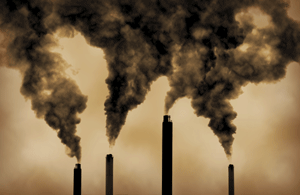Emission trading scheme is starting to bite
on
Emission trading scheme is starting to bite
The future structure of Europe’s flagship climate instrument, its emission trading scheme (ETS), is currently being pieced together in Brussels. Starting in 2013, the power sector will have to buy CO2-allowances for some €15 billion a year at current CO2-prices. The industrial sector will get part, though not all, of its allowances for free, at least until 2020. Power companies complain that it is taking too long for the auctioning of allowances to get started. Industry sources complain that the ETS is going to drive up costs and hamper innovation. How effective the ETS will be in stimulating low-carbon investment remains to be seen.
 |
| It's not clear if and to what extent carbon price is driving investments in emission reductions |
The idea behind the ETS is that the price put on carbon works as an incentive for companies to cut their emissions. The first two phases of the carbon trade scheme, however, which ran from 2005 to 2007 and 2008 to 2012, have yielded meagre results so far. In the first phase the carbon price crashed because too many allowances were distributed. The price collapsed from highs of around €30 per tonne at the end of 2005 to zero at the end of 2007. The second phase, which is currently taking place, is grappling with a similar over-supply problem, caused this time by the recession, which has led to sharply reduced emissions. Nevertheless, the CO2-price has been fairly stable since the end of 2008 at around €15 per tonne. It is not clear, however, if and to what extent this price is driving investments in emission reductions. Policymakers are now pinning their hopes on the upcoming third phase, from 2013-20. This is when the ETS is expected to really start to bite.
Seemingly technical
The broad framework of what the third phase will look like was decided in 2008. The overall ceiling of CO2 emissions has been set to ensure a 21% reduction of CO2-emissions compared to 2005. But the system by which emission allowances are granted, differs from the earlier two phases in at least two important ways. First, allowances will be divided up among sectors rather than countries and they will be distributed directly by Brussels rather than via the member states. This is to prevent national
| With nearly two billion allowances to be distributed annually during the third phase, there is – at the current price of €15 per tonne – some €30 billion at stake each year |
Although this broad framework has been agreed upon, there are still a host of seemingly technical details that have yet to be worked out. This pertains for instance to how and when the sale of allowances will take place and who will get how much for free. Inevitably these “technical” details have proved to be intensely political. With nearly two billion allowances to be distributed annually during the third phase, there is – at the current price of €15 per tonne – some €30 billion at stake each year.
Timing
In the distribution of allowances the ETS makes a distinction between the power sector on the one hand and the industrial sector on the other. The power sector will have to buy nearly all of its allowances from 2013. How many allowances companies will need to buy for each of their installations is determined by the European Commission on the basis of the national allocation plans from the second phase (i.e. based on the allowances the installations received in the past), but with a deduction in order to reduce CO2-emissions further. A special formula is used to calculate the allowances that must be bought by newly to be built installations. The rules for the industrial sector are completely different, as we will discuss below.
Overall, over half of the total number of allowances for 2013-20 will go to the power sector, and hence will be auctioned. In the current, second phase of the ETS just 4% of the allowances is auctioned, the remainder is distributed for free. Since the total number of allowances that are available is two billion per year, this means the power sector will have to buy about one billion allowances per year. At the current carbon price this equates to some €15 billion in value.
In July, EU member states agreed a set of rules governing the auction of allowances to the power sector. These rules are set to be officially adopted in December after receiving a stamp of approval from the European Parliament. The main worry for power companies at this moment is not what is in these rules, however, but what is not in them: namely the number of allowances that will be put up for sale
| The UK, Germany, Spain and Poland formed a blocking minority and got their way: member states may choose to opt out of the new common EU platform and set up their own |
‘This is the biggest issue for us,’ says Nicola Rega, environment and sustainable development advisor at Eurelectric, the association of European electricity companies, ‘the volumes being auctioned [before 2013] and when.’ The Commission is looking at early auctions for 2012, he says, but from Eurelectric’s perspective they must start in 2011.
The timing of the auctioning process is worrying the industry more than the volumes at stake. In May, Commission climate policy official Peter Zapfel said there appeared to be consensus that 100-300 million of the more than 1 billion allowances to be auctioned for 2013 should be sold early to help the power sector plan ahead. ‘We are talking about 200-400 million, so we see some convergence’, Rega says.
Multiple platforms
During the auctioning regulation’s preparation, the biggest political hot potato was not early auctions however, but whether to have a single EU auctioning platform or several. Despite the Commission’s strong preference for a single platform – in which it was backed by the vast majority of stakeholders, from Eurelectric and the International Emissions Trading Association (IETA) to WWF – a handful of member states insisted on the ability to set up their own national auctioning platforms. Together, the UK, Germany, Spain and Poland formed a blocking minority and got their way: member states may choose to opt out of the new common EU platform and set up their own.
 |
| The EU's Emission Trading Scheme is a unique ceiling on the carbon emissions of power plants and industrial installations |
While forced to concede to multiple platforms, the Commission stood its ground over tough controls for these. They must be notified to the Commission within three months after the auctioning regulation enters into force and the Commission will be able to propose suspending them if it feels they breach auctioning rules. Such sanctions would have to be approved by member states and the European Parliament. Member states that set up their own platforms will be monitored by an independent body appointed by the EU and face onerous translation requirements. But they will be free to set their own auction dates and volumes, within certain constraints, such as a minimum number of allowances per auction. Their auction plans for the year ahead must be published by 31 March each year, while those of the common platform are due by 28 February.
How many platforms will be established and how they will function is still uncertain, market players say. One thing that the Commission has ordained is that all allowances must be auctioned in the form of spot products rather than forwards or futures. This measure will have a strong impact on the dynamics of the market. ‘Having to pay now, before you need the carbon, will have a short-term cash flow impact,’ says Alexandre Marty, head of policy for carbon and environmental markets at EDF Trading.
Utilities would have preferred to be able to trade in futures or forwards, but the Commission argued that spot products do not lock in the trading of auctioned allowances to a particular auction platform. This promotes competition in the secondary market, where players trade allowances with one another. Meanwhile, the existence of multiple platforms and very short windows between auctions could disadvantage smaller companies. They may not have the staff to handle several platforms and analyse auction results fast enough.
How “transparent” the carbon price signal will be when spread over several auctioning platforms, remains to be seen. If some platforms become more attractive than others, would this lead to different carbon prices? No one has an answer today.
Exaggerated
Unlike power plants, industrial installations will only have to pay for part of their CO2-emissions. They will get 80% of their allowances for free in 2013, declining to 30% in 2020, but only if they meet certain effiency benchmarks (and hence have relatively low CO2-emissions). Industries that do not meet these benchmarks, will have to buy extra allowances to make up for their extra CO2-emissions. The Commission is currently calculating some 50 product benchmarks for 20 sectors, all of which must then be approved by the member states. A benchmark reflects the average emissions of the 10% most efficient installations in a sector in 2007-8, independent of technology and fuel.
However, an exception has been made for industries that compete internationally with companies from the US, Asia or elsewhere that do not have restrictions on CO2-emissions. These will continue to get all of their allowances for free up to the relevant benchmark. This is to prevent what is called “carbon leakage”, i.e. the risk that companies will relocate to areas without CO2-standards, which would harm the EU’s economy without having any effect on global CO2-emissions.
Last December the EU agreed to put 164 sectors on a carbon leakage risk-list. Together these account for over three-quarters of industrial emissions covered by the scheme (and around a quarter of total EU ETS emissions). Some external observers say the list has been stretched for political reasons. In a
| ‘The ETS favours products with low added-value, while we need to innovate to keep Europe competitive’ |
As to the benchmarks, despite the high stakes and potential for dispute, draft figures that emerged this summer appear close to what industrial sectors themselves have proposed. For example, the Commission’s climate department is proposing a benchmark of 305 kg CO2 emissions per tonne of coloured glass for bottles and jars, compared with the industry’s proposal of 310 kg CO2 per tonne. And it is proposing 378 kg CO2 per tonne for colourless glass versus the industry’s 380 kg CO2 per tonne.
Industry worries
Although industry does not seem inclined to nit-pick too much about benchmark numbers that are largely based on data supplied by industry anyway, businesses are nevertheless concerned with how many allowances they will still need to pay for, how much money this will add up to and how this will impact on their competitiveness.
Europia, representing European refineries, estimates that its sector will still end up forking out €1 billion a year if the current draft benchmark for refineries is implemented. This equates to 13% of operating costs. Their biggest concern, says deputy secretary general Chris Beddoes, is that up to a quarter of refineries will still have to buy as many as half their allowances. The industry is caught in a paradox, he adds. Policymakers are pressuring it to both reduce and raise emissions by subjecting it to the EU ETS on the one hand and laws demanding cleaner fuels on the other. Cleaner fuels are more CO2-intensive because they require more refining.
 |
| Caught in a paradox: cleaner fuels are more CO2-intensive because they require more refining |
Robert Jan Jeekel from Eurometaux, representing non-ferrous metals, points out that not taking into account different fuel types will penalise some installations that are forced to use more carbon-intensive heavy fuel oil because the gas grid does not reach them. This is the case for an alumina plant in Spain. Jeekel also points out that the recycling of scrap metal gets no incentives because the higher emissions this process causes are not taken into account.
Draft benchmarks for the steel sector have yet to be developed because of an ongoing dispute over how to treat waste gases. The steel sector wants 100% free allowances for the emissions from electricity produced using its waste gases. The Commission is proposing 75%. Brussels argues that the natural gas these waste gases substitute would emit only a quarter of the carbon in their stead. This is because
| After two relatively relaxed phases, industry and power companies will really start to feel the pressure of the CO2 emission scheme bearing down on their businesses |
Other issues still under discussion include a benchmark for cement and whether this should take into account the potential for this sector to further reduce its emissions. Integrating reduction potential would set a new precedent that could trigger the revision of other draft benchmarks. There are also indications the Commission wants to tighten the benchmark over the 2013-20 period. European employers’ association BusinessEurope argues instead that the benchmarks should be made more lenient at the start of the period, only reaching the level where they are based on the top 10% of installations in 2007-2008 at the end of the third phase. The production reference years are also still under discussion, as are rules for dealing with new entrants, capacity increases, and closures.
With 2013 fast approaching, it is clear that although the ETS puzzle has not been completed, many of the pieces are now falling into place. After two relatively relaxed phases, industry and power companies will really start to feel the pressure of the CO2 emission scheme bearing down on their businesses. Whether this will actually lead to lower emissions, drive low-carbon investment, and stimulate innovation and efficiency, as the proponents of the ETS believe, is still an open question.
|
This is the first in a series of articles EER will publish on the upcoming next phase of the European Emission Trading Scheme. If you have comments or suggestions, you can contact the editor at karel.beckman@europeanenergyreview.eu. |


Discussion (0 comments)